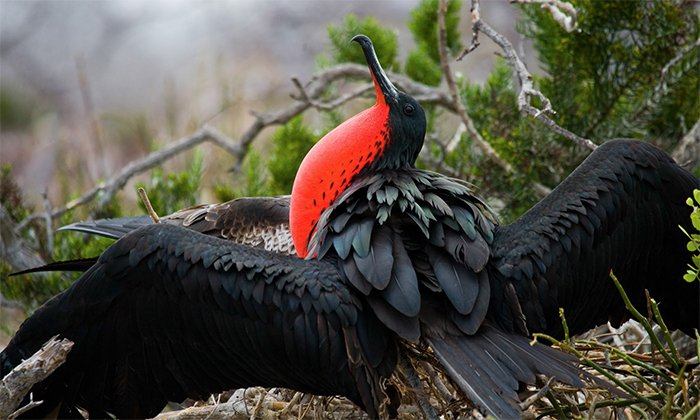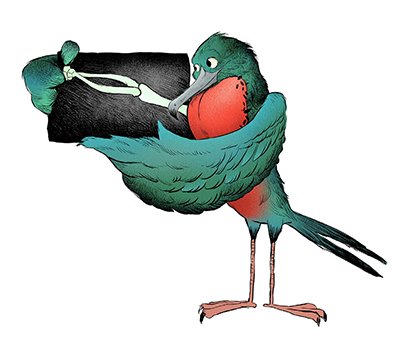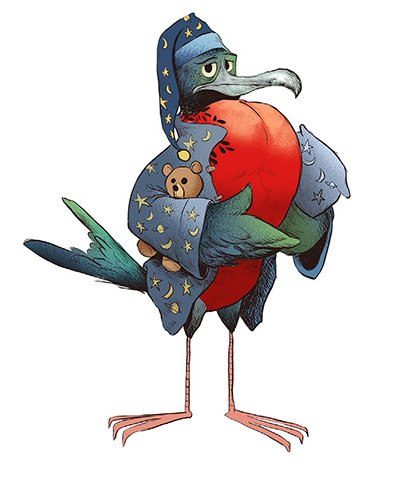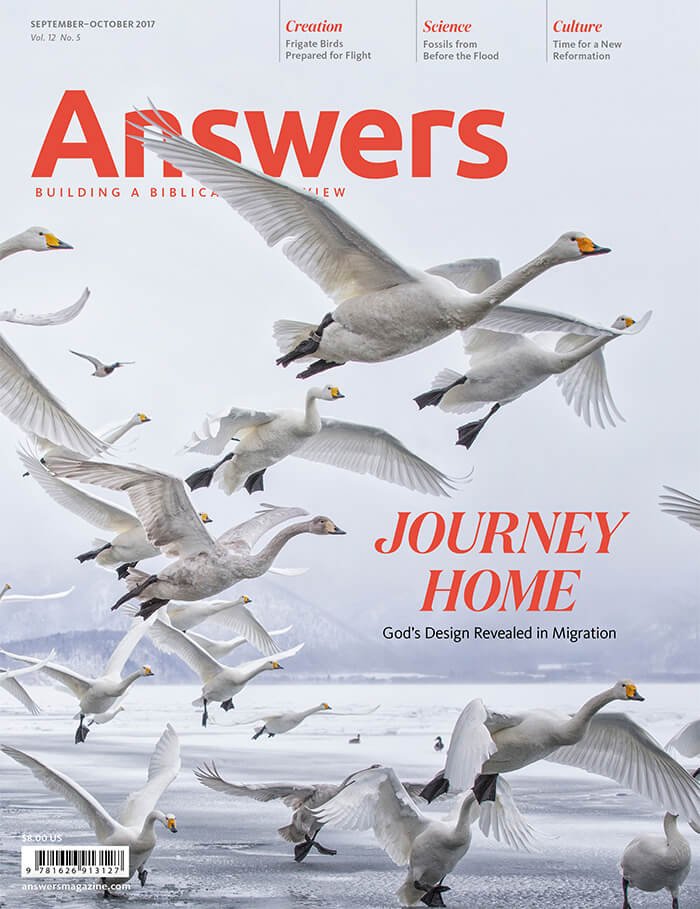Prepared for Perpetual Flight
Some birds don’t know when to quit, like the great frigatebird. It’s uniquely designed to stay aloft for weeks without touching the ground.
“This is your pilot speaking. We’re just going to shut down the engines and take a little nap up here in the cockpit, so enjoy the view of the Indian Ocean, and we’ll get back to you after a few winks. Flight attendants, please don’t disturb us until you hear the engines restart.”
Sound like a nightmare? Sane pilots don’t shut down their engines and take naps mid-flight! But the great frigatebird does that all the time. This amazing creature can stay aloft for weeks without ever landing. It even sleeps while in flight.
Designed to Fly
Great frigatebirds’ huge size belies their low weight. Their bodies are up to 3.4 feet (105 cm) long, and their wingspans stretch an incredible 7.5 feet (230 cm), yet they weigh less than 4 pounds (1.8 kg). This ratio of weight to wing area (known as wing loading in “bird speak”) is the lowest of any bird’s. If a fair breeze is blowing, all they need to do is open their wings and . . . they’re aloft! Frigatebirds in flight are unmistakable; their forked tails and long, narrow wings give them a distinctive streamlined appearance.
Dinner on the Fly
Great frigatebirds are designed to do everything on the fly. Although most of their food comes from the ocean, they avoid landing on the water for several reasons. Their legs and feet are extremely small and weak, making swimming impossible; their plumage is not waterproof; and their large, cumbersome wings make it difficult if not impossible to take off from the water.
Great frigatebirds are designed to do everything on the fly.
But in the air, they are masters! So frigatebirds scoop up small fish from the surface without ever touching down. They are also notorious for their pirate-like behavior, stealing fish from other seabirds. Hence the name frigatebird, reminiscent of the swift frigates that pirates sailed to run down slower ships and steal their booty.
While working as a wildlife biologist on Johnston Atoll in the Pacific, I observed this behavior many times. Frigatebirds would chase boobies or other smaller seabirds as they were returning to their nests. After a brief chase, the smaller bird would tire and disgorge its meal. Instantly the “pirate” would catch the fish, usually in midair!

To woo a mate, the great frigatebird inflates his bright red throat sac and shakes his head from side to side, rattling his bill. If a female is impressed, she comes down to nest and raise young.
A Life Aloft
Frigatebirds are designed to live in the open ocean, where they can stay aloft for weeks and even months at a time. They seek out cumulus clouds, which are formed by rising air. Then they circle in the updrafts, the only birds known to fly into a cloud intentionally. They ride the updrafts like an elevator, rising as high as 13,000 feet (4,000 m), and then slowly glide down for several miles.
They also sleep on the fly. How can frigatebirds do this without falling out of the sky? Researchers recently found the answer.
How can frigatebirds do this without falling out of the sky? Researchers recently found the answer.
Birds can sleep in two different ways: both brain hemispheres sleep at once, or only one hemisphere is in sleep mode (known as unihemispheric slow wave sleep—USWS). During USWS, birds can keep one eye open and monitor their environment while still getting rest. Ducks also sleep this way on the water’s surface.
In 2014, scientists in the Galápagos Islands studied the brain wave activity of great frigatebirds while the birds were aloft continuously for up to 10 days. Amazingly, they recorded both kinds of sleep, mostly while the birds were circling in thermal updrafts at night. They seem to be able to get maximum benefit from a little shuteye, using whichever method is safest at any moment.
In fact, it turns out the birds in flight slept very little—an average of 41 minutes per day, in short snatches of about 12 seconds each. Scientists don’t yet understand how frigatebirds can survive on so little sleep for such a long time without suffering adverse effects as most other animals (and humans) would. Each new discovery seems to uncover one more mystery to ponder about our Creator’s marvelous handiwork.
First Corinthians 15:39 tells us, “Not all flesh is the same, but there is one kind for humans, another for animals, another for birds, and another for fish.
” Birds display God’s infinite creativity in ways other creatures can’t. And each species shows his unique provision for every one of his creatures. Who would expect a seabird that avoids getting wet and sleeps in the air?
Did You Know . . .

Illustration by Dave Mottram
Great frigatebirds’ bones are mostly hollow, so their skeleton accounts for less than 5% of their total body weight. This statistic is unmatched in the bird kingdom.
The male frigatebird has the most spectacular courtship display of any seabird. While perched, he searches the sky for a female. When he finds one, he woos her down by displaying his bright red, inflated throat sac. At the same time, he rapidly shakes his head from side to side and noisily rattles his bill. If she likes what she sees, the two will proceed to nest, lay just one egg, and share parental duties for several months.
The frigatebirds’ diet consists mainly of flying fish, which leap out of the water to escape sharks and other predatory fish. But they’re not picky, as long as it’s easy prey.

Illustration by Dave Mottram
Although frigatebirds in flight sleep in short snatches, on land they sleep for more than 12 hours per day.
Answers Magazine
September–October 2017
The Creator equipped numerous animals with astonishing tools to find their way as they migrate around the world.
Browse IssueRecommended Resources

Answers in Genesis is an apologetics ministry, dedicated to helping Christians defend their faith and proclaim the good news of Jesus Christ.
- Customer Service 800.778.3390
- Available Monday–Friday | 9 AM–5 PM ET
- © 2025 Answers in Genesis




